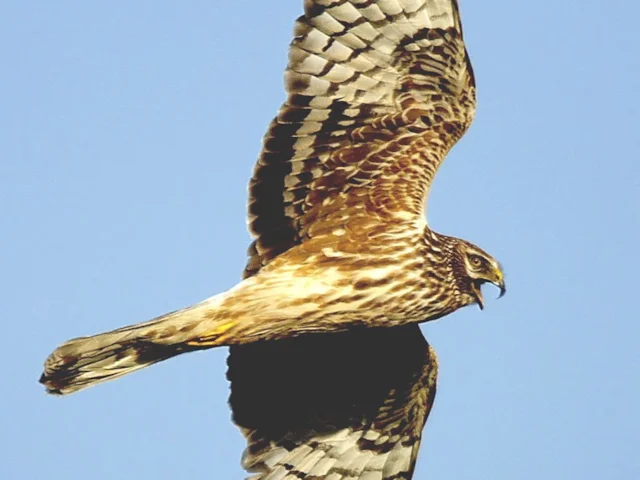Keep a look out for Hen Harriers
17c0e424-6e96-4de0-90e2-872744bd5195

The RSPB is asking people who spend time in the uplands of Cumbria to keep their eyes peeled for Hen Harrier, England’s most threatened bird of prey.
The conservation charity has relaunched its Hen Harrier Hotline, now in its seventh year, in the hope of discovering where these birds are potentially breeding. The uplands of Northern England has the ecological potential to hold at least 320 pairs of breeding Hen Harriers, but last year not a single chick was raised in the whole of England.
Amanda Miller, Conservation Manager for the RSPB in Northern England, said: “The lack of breeding success is not through lack of effort. The male is famous for its spectacular courtship display known as 'skydancing', in which it tries to attract a female with a series of high altitude swoops and somersaults. It’s like watching nature’s equivalent of the Red Arrows.”
The main reason Hen Harrier has reached this crisis point is that the species suffers from constant illegal persecution. In addition to their diet of small birds and mammals, the species sometimes eats grouse which brings them into conflict with the shooting community. Driven grouse shooting requires large numbers of birds, and sadly some game managers feel they must illegally kill or disturb any harriers present to protect their stock.
A government-commissioned scientific report published in 2011 found that illegal persecution continues to be the biggest single factor preventing Hen Harrier recovery in England – a fact confirmed by the recovery of shot harriers in both the Yorkshire Dales and Aberdeenshire in 2012.
Amanda Miller continued: “The English Hen Harrier is on the edge of extinction as a breeding bird. It is therefore critical that we are able to locate and protect any birds that may be nesting. As the species tends to breed in remote moorland areas, we rely on walkers, cyclists and other people who spend their free time in the uplands to help our on-the-ground team by letting us know if they see one.”
Male Hen Harriers is ash-grey with black wing-tips and a wingspan of just less than a metre. The female is slightly larger, perhaps more owl-like in appearance, and has a mottled brown plumage which camouflages it when nesting on the ground. Juveniles and females have obvious horizontal stripes on their tails, giving them the nickname 'ringtail', along with a patch of white on the rump.
The Harrier Hotline number is 0845 4600121 (calls are charged at the local rate). Reports can also be e-mailed to henharriers@rspb.org.uk. Reports of sightings should include the date and location of the sighting, including a six-figure grid reference where possible.
For more information about the RSPB's ongoing Skydancer project, visit www.rspb.org.uk/skydancer.
The conservation charity has relaunched its Hen Harrier Hotline, now in its seventh year, in the hope of discovering where these birds are potentially breeding. The uplands of Northern England has the ecological potential to hold at least 320 pairs of breeding Hen Harriers, but last year not a single chick was raised in the whole of England.
Amanda Miller, Conservation Manager for the RSPB in Northern England, said: “The lack of breeding success is not through lack of effort. The male is famous for its spectacular courtship display known as 'skydancing', in which it tries to attract a female with a series of high altitude swoops and somersaults. It’s like watching nature’s equivalent of the Red Arrows.”
The main reason Hen Harrier has reached this crisis point is that the species suffers from constant illegal persecution. In addition to their diet of small birds and mammals, the species sometimes eats grouse which brings them into conflict with the shooting community. Driven grouse shooting requires large numbers of birds, and sadly some game managers feel they must illegally kill or disturb any harriers present to protect their stock.
A government-commissioned scientific report published in 2011 found that illegal persecution continues to be the biggest single factor preventing Hen Harrier recovery in England – a fact confirmed by the recovery of shot harriers in both the Yorkshire Dales and Aberdeenshire in 2012.
Amanda Miller continued: “The English Hen Harrier is on the edge of extinction as a breeding bird. It is therefore critical that we are able to locate and protect any birds that may be nesting. As the species tends to breed in remote moorland areas, we rely on walkers, cyclists and other people who spend their free time in the uplands to help our on-the-ground team by letting us know if they see one.”
Male Hen Harriers is ash-grey with black wing-tips and a wingspan of just less than a metre. The female is slightly larger, perhaps more owl-like in appearance, and has a mottled brown plumage which camouflages it when nesting on the ground. Juveniles and females have obvious horizontal stripes on their tails, giving them the nickname 'ringtail', along with a patch of white on the rump.
The Harrier Hotline number is 0845 4600121 (calls are charged at the local rate). Reports can also be e-mailed to henharriers@rspb.org.uk. Reports of sightings should include the date and location of the sighting, including a six-figure grid reference where possible.
For more information about the RSPB's ongoing Skydancer project, visit www.rspb.org.uk/skydancer.

